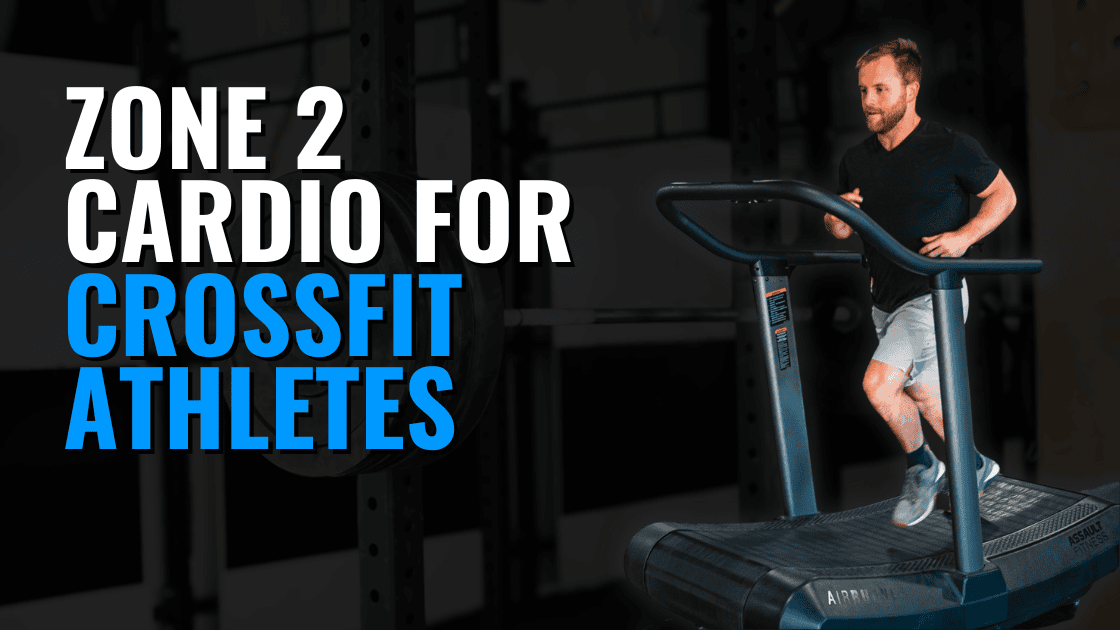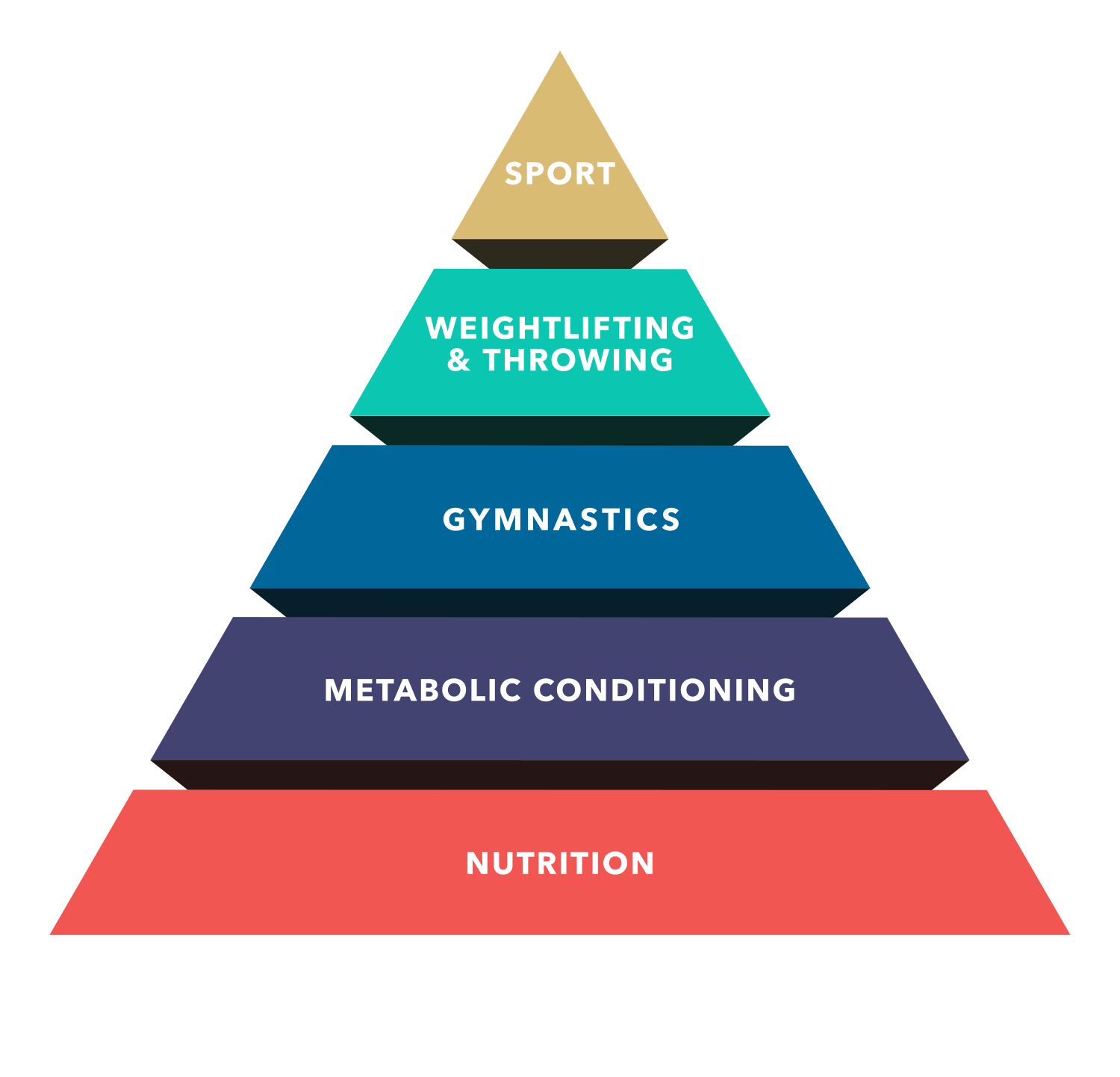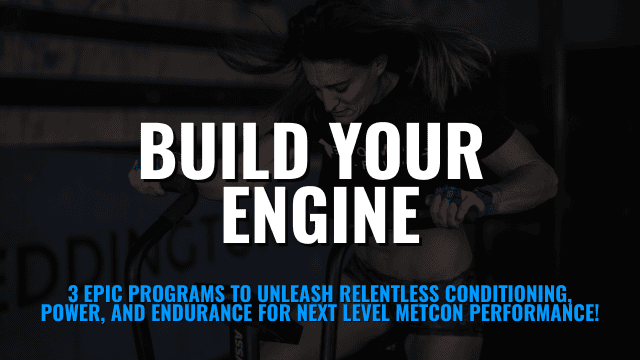Let’s be honest: Throwing heavy barbells, swinging from rings, and crushing a high-intensity metcon is much more fun than steady-state cardio. But for many CrossFit athletes, lower-intensity training can be the best way to improve their gym performance. This article will outline why we should do more Zone 2 cardio for CrossFit Athletes.
Zone 2 Cardio for CrossFit Athletes
What Does Zone 2 Cardio Do?
In energy systems training, you will often hear discussions of different “zones” of training (image below). These zones refer to different training intensities, with zone 2 being a relatively easy training zone to workout in with a heart rate between 60-70% of maximum. Compared to your traditional CrossFit metcon, this will be dramatically less intense.

When Zone 2 cardio is mentioned to CrossFit athletes, the question is always asked: Why perform it when it is so much easier than the WODs done in CrossFit?
While there is no denying that high-intensity training provides the biggest fitness return for your time, it doesn’t mean we won’t see more fitness improvements with additional lower-intensity training. In fact, several physiological adaptations occur with Zone 2 work that you won’t get at higher intensities.
Zone 2 Cardio Benefits
When you perform Zone 2 work, your heart rate is only slightly elevated. The result of this is that you get an eccentric stretching of your heart’s left ventricle. Ultimately, this will stretch your heart to pump more blood with each beat, creating positive adaptations for your higher-intensity workouts. This adaptation only happens with lower-intensity training. If your heart rate gets too high, the left ventricle won’t have time to fill with blood to get that eccentric stretch.
When performing higher-intensity training, our body produces metabolic byproducts, the things that create the “burn” as you work out. Athletes with a higher aerobic base (what Zone 2 builds) can clear those byproducts more easily. They also have a higher anaerobic threshold, the exercise intensity at which training fatigue accumulates rapidly. In other words, you can sustain higher work output before crashing. A big win in CrossFit!
Finally, Zone 2 work will increase mitochondria density within your muscle fibers. Mitochondria are the powerhouses of your cells.
Taken as a whole, increasing your aerobic base will help you be more fatigue-resistant, better recover between sets in a workout, and recover more rapidly between workouts. CrossFit itself places so much emphasis on metabolic conditioning in its methodology, but we often find gyms overemphasizing the intensity of a week of training and neglecting the long, slow work.
To be clear, CrossFit itself has the greatest ROI for pushing your fitness forward. But if you want to add in some extra Zone 2, it won’t impact your recovery much at all. And, if you’re feeling overtrained, it can be a great way to reduce training stress while still improving your performance.
How Do I Train in Zone 2?
As discussed above, when doing Zone 2 cardio to try and build your aerobic base, we can’t exercise too intensely. We want to stay at low to moderate levels of cardiovascular exertion and power output.
Zone 2 workouts should last 30-90 minutes and be performed at 60-70% of your maximum heart rate. There are many calculators online, but a simple formula is:
(220 – age) x 60%-70% = your Zone 2 heart rate
Using your heart rate to track requires the use of a heart rate monitor strap such as this Polar monitor.
You can also perform Zone 2 cardi by following the “talk test.” For the talk test, keep your intensity at a level that would allow you to talk to another athlete while performing, although you will still sound a little breathy during your exercise.
Note: this workout will feel slower and less intense than your CrossFit-style WOD. That is the key to this style of training. If your heart rate gets too high, you will not allow enough time between beats to fill your heart’s left ventricle with blood to stretch it out. Stay slow!
Zone 2 Cardio for CrossFit Examples
Your aerobic fitness is the foundation of your sports performance for CrossFit athletes. So many workouts in this sport are based on your ability to rapidly recover from lifting moderate weights for 8-15 minutes. We recommend that CrossFit athletes perform 1-2 sessions of Zone 2 work per week.
Your schedule may look like this:
- Monday: CrossFit
- Tuesday: CrossFit
- Wednesday: CrossFit
- Thursday: Zone 2 work
- Friday: CrossFit
- Saturday: CrossFit partner WOD
- Sunday: Off Day or Zone 2 Cardio
The beautiful part about Zone 2 work is that it creates very little fatigue. So you will notice that the above schedule follows CrossFit’s 5 days per week recommendation. But we’re adding 1-2 days of Zone 2. It would be hard to add in two more high-intensity metcons to this week but Zone 2 work is rarely too challenging to recover from in an example like this.
Example WODS that should be scaled to keep intensity correct:
WOD 1 – a 60 minute hike or fast-paced walk
WOD 2 – 10-20-30-40-50-40-30-20-10
- Cal Bike
- Cal Row
- Move up/down the ladder as far as you can in 30-40 minutes
WORKOUT 3 – E6x5 rounds.
- 600m run.
- 1200m bike.
- Max single unders in the remaining time
WOD 4 – 40min EMOM.
- 12-18 cal Bike Erg (chose a sustainable number of calories)
- 50m Front rack carry
- 12-18 cal Row
- Shuttle run (4x25m)
WOD 5 – AMRAP 30
- 15 Cals Bike Erg or Run
- 12 KB Swing 53/35
- 9 Toes to Rings
Unleash Relentless Conditioning, Power, and Endurance for Next Level MetCon Performance!
Take your fitness to the next level with our Build Your Engine programs. Whether you’re crushing WODs or preparing for competition, this targeted training plan helps you develop the three major metabolic pathways that will skyrocket your metcon performance. With expert programming designed for CrossFit athletes, it’s your blueprint to build a powerful engine and dominate every workout.








